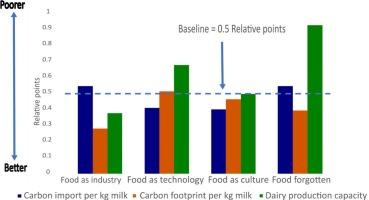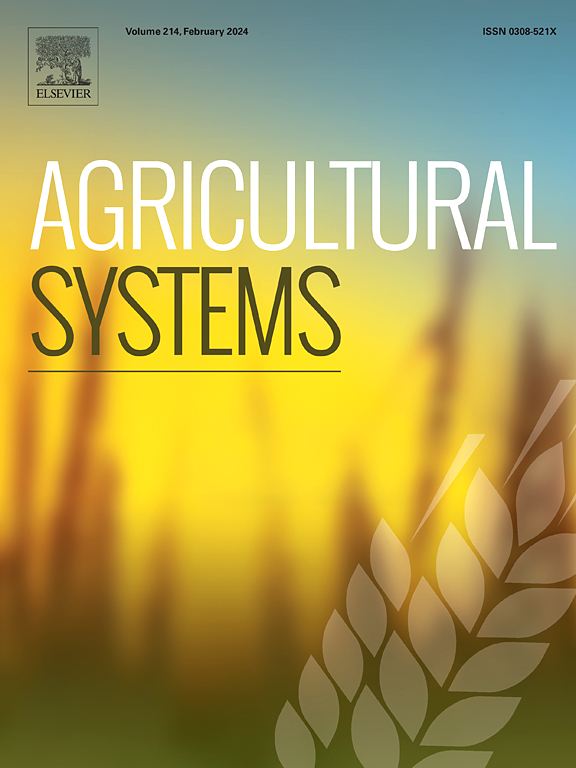The dairy production system in the north of Sweden under possible future food scenarios
IF 6.1
1区 农林科学
Q1 AGRICULTURE, MULTIDISCIPLINARY
引用次数: 0
Abstract
Context
The dairy production system fills an important role by providing nutrient-dense foods in Swedish diets, however, future efforts to improve its sustainability necessitate structural changes.
Objective
We present an innovative study which assesses the effects of these future changes in the dairy system in northern Sweden, the Norrland region, which has a subarctic climate.
Methods
Four scenarios were developed: 1) Food as Industry: Food is a commodity, and its production is an industry that can be invested in to benefit society. 2) Food as Technology: New technologies, such as nutrient density trackers and microbiome mapping, are used for personalized dietary plans. Additionally, novel foods from microbial cultures are produced. 3) Food as Culture: More locally produced food and diverse food products are consumed. 4) Food Forgotten: Land previously used for food and feed is converted to bioenergy production, climate mitigation, and adaptation infrastructure. These scenarios were compared to the baseline i.e. present dairy system for dairy production capacity, carbon flow and carbon footprint.
Results and conclusions
Food as industry resulted in increased dairy production capacity with decreased carbon footprint but increased carbon imports. Food as technology provided decreased dairy production capacity and increased carbon footprint but with decreased carbon imports. Food as culture, maintained dairy production capacity with a decreased carbon footprint and carbon imports. Food forgotten resulted in decreased dairy production capacity and increased carbon imports but with decreased carbon footprint. Food as culture benefits all - specifically dairy production capacity, carbon footprint and carbon imports. However, further research is required to explore implications on soil organic carbon stocks over time in Norrland.
Significance
Our study sheds light on the potential impacts of future dairy production in a subarctic climate and aims to help in decision making.

未来可能出现的食品情况下瑞典北部的奶制品生产系统
背景乳制品生产系统为瑞典人的饮食提供了营养丰富的食品,发挥了重要作用,然而,未来要提高其可持续性,就必须进行结构性改革:1) 食品工业:1) 食品作为产业:食品是一种商品,其生产是一种产业,可以通过投资造福社会。2)食品即技术:营养密度追踪器和微生物组图谱等新技术被用于个性化饮食计划。此外,还利用微生物培养物生产新型食品。3) 食物即文化:消费更多本地生产的食品和多样化的食品。4) 食物被遗忘:以前用于粮食和饲料的土地被转化为生物能源生产、气候减缓和适应基础设施。结果和结论 "粮食即产业 "提高了乳品生产能力,减少了碳足迹,但增加了碳进口。作为技术的食品降低了乳品生产能力,增加了碳足迹,但减少了碳进口。作为文化的食物保持了乳制品生产能力,减少了碳足迹和碳进口。被遗忘的食物导致乳制品生产能力下降,碳进口增加,但碳足迹减少。食物即文化惠及所有人--特别是乳制品生产能力、碳足迹和碳进口。我们的研究揭示了未来乳制品生产在亚北极气候条件下的潜在影响,旨在帮助决策制定。
本文章由计算机程序翻译,如有差异,请以英文原文为准。
求助全文
约1分钟内获得全文
求助全文
来源期刊

Agricultural Systems
农林科学-农业综合
CiteScore
13.30
自引率
7.60%
发文量
174
审稿时长
30 days
期刊介绍:
Agricultural Systems is an international journal that deals with interactions - among the components of agricultural systems, among hierarchical levels of agricultural systems, between agricultural and other land use systems, and between agricultural systems and their natural, social and economic environments.
The scope includes the development and application of systems analysis methodologies in the following areas:
Systems approaches in the sustainable intensification of agriculture; pathways for sustainable intensification; crop-livestock integration; farm-level resource allocation; quantification of benefits and trade-offs at farm to landscape levels; integrative, participatory and dynamic modelling approaches for qualitative and quantitative assessments of agricultural systems and decision making;
The interactions between agricultural and non-agricultural landscapes; the multiple services of agricultural systems; food security and the environment;
Global change and adaptation science; transformational adaptations as driven by changes in climate, policy, values and attitudes influencing the design of farming systems;
Development and application of farming systems design tools and methods for impact, scenario and case study analysis; managing the complexities of dynamic agricultural systems; innovation systems and multi stakeholder arrangements that support or promote change and (or) inform policy decisions.
 求助内容:
求助内容: 应助结果提醒方式:
应助结果提醒方式:


